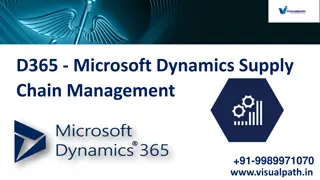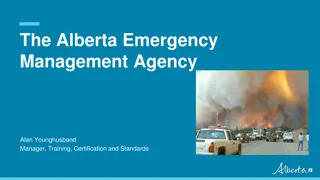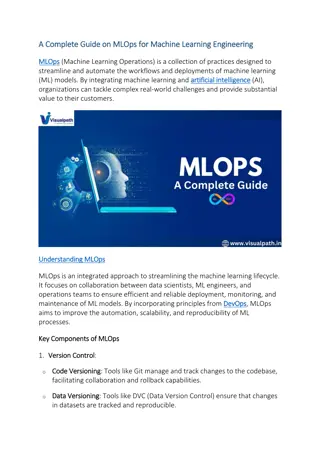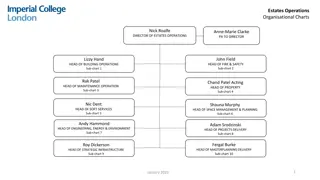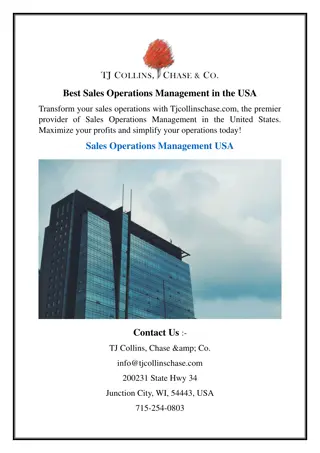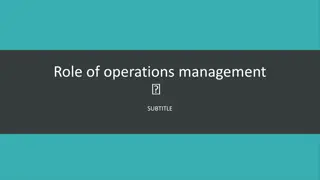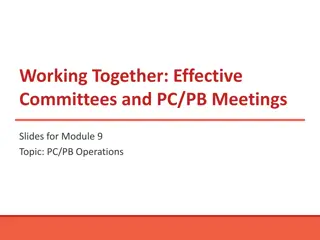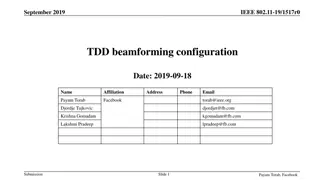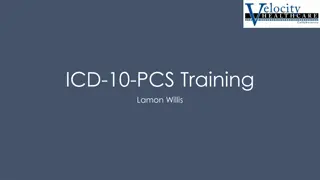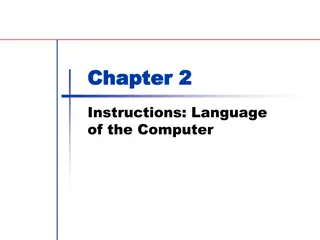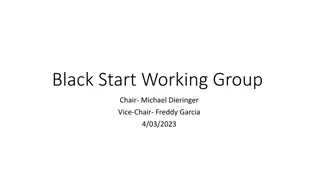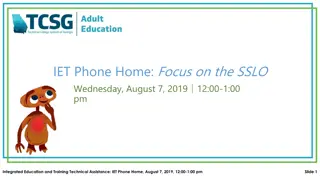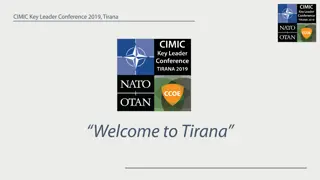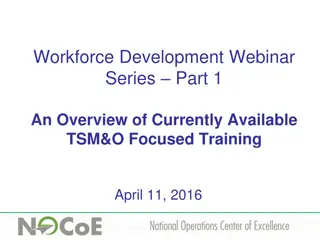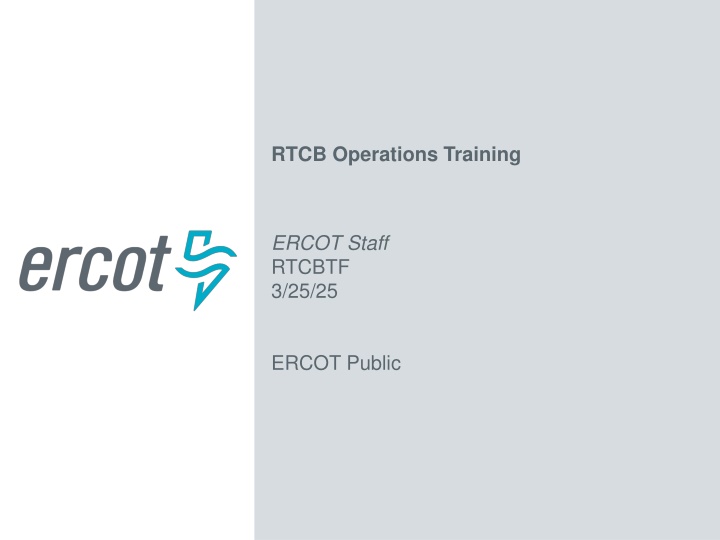
AS Procurement in ERCOT for Efficient Energy Management
Learn about AS procurement processes in ERCOT, including Day-Ahead Market dynamics, AS responsibilities, HSL concepts, and the role of Supplemental AS Market for reliable energy management.
Download Presentation

Please find below an Image/Link to download the presentation.
The content on the website is provided AS IS for your information and personal use only. It may not be sold, licensed, or shared on other websites without obtaining consent from the author. If you encounter any issues during the download, it is possible that the publisher has removed the file from their server.
You are allowed to download the files provided on this website for personal or commercial use, subject to the condition that they are used lawfully. All files are the property of their respective owners.
The content on the website is provided AS IS for your information and personal use only. It may not be sold, licensed, or shared on other websites without obtaining consent from the author.
E N D
Presentation Transcript
RTCB Operations Training ERCOT Staff RTCBTF 3/25/25 ERCOT Public
Agenda Outline AS Procurement Today AS Procurement in RTC+B (and other impacts) Detailed AS Changes Wrap-up ERCOT Public
Acronyms Ancillary Services (AS) Ancillary Service Demand Curve (ASDC) Controllable Load Resource (CLR) Current Operating Plan (COP) Day-Ahead Market (DAM) ERCOT Contingency Reserve Service (ECRS) High Sustained Limit (HSL) Load Frequency Control (LFC) Load Resource (LR) Load Serving Entity (LSE) Locational Marginal Price (LMP) Low Power Consumption (LPC) = (LSL in EMS) Low Sustained Limit (LSL) Max Power Consumption (MPC) = (HSL in EMS) Market Clearing Price for Capacity (MCPC) Net Power Consumption (NPC) Nodal Protocol Revision Request (NPRR) Non-Spinning Reserve Service (Non-Spin) Operating Reserve Demand Curve (ORDC) Qualified Scheduling Entity (QSE) Real-Time Co-optimization (RTC) Real-Time Market (RTM) Regulation Down (Reg-Down) Regulation Up (Reg-Up) Resource Limit Calculator (RLC) Responsive Reserve Service (RRS) Security-Constrained Economic Dispatch (SCED) Supplemental Ancillary Service Market (SASM) Under-Frequency Relay (UFR) 3 ERCOT Public
Ancillary Services Procurement Today ERCOT Public
AS Procurement Today (Reminder) The Day-Ahead Market (DAM) is voluntary except for the Ancillary Services that are procured in DAM. After DAM publishes, QSEs update their Current Operating Plans (COPs) to reflect online resources and specify AS responsibilities on resources prior to DRUC. Awarded QSEs can manage/move AS responsibilities across their fleet (reserve AS capability on Resources) o HSL = High Sustained Limit (eg 100MW unit) o HASL = HSL AS (if carrying 10MW AS, then HASL = 90) If QSE fails to provide AS, ERCOT Supplemental AS Market (SASM) can be run o ERCOT Operator initiates Supplemental AS Market (SASM) to replace missing AS o Takes up to two hours to announce and execute SASM o Not efficient replacement market (slow and usually expensive) HSL HASL ERCOT Public 5
AS Procurement in Real-Time Co-optimization ERCOT Public
AS Procurement in RTC In RTC: DAM still clears Energy and AS However .. DAM awards are only financially binding, and based on the DAM results the QSE chooses how to update their Resource COPs to be online or not be online. QSE management of AS responsibility across their portfolio no longer exists. DRUC/HRUC become the tools to assess if enough capacity is available to ensure RTC SCED will have enough capacity to solve for energy and AS capacity. In real-time SCED co-optimizes and clears Energy and AS Co-optimization is clearing multiple products at same time for optimal solution 7 ERCOT Public
What components of the market are changing with RTC+B project? ERCOT Public
Todays Real-Time Market is designed to reflect scarcity through a process that is outside of the optimization Currently Energy Offers Security- Constrained Economic Dispatch (SCED) Base Points Telemetry Locational Marginal Prices (LMPs) Combined to form Settlement Point Prices Constraints (Amount of Energy limited by QSE HASL) Operating Reserve Demand Curve (ORDC) Price Adders Reserve Pricing 9 ERCOT Public
RTC is also designed to reflect scarcity, but now it occurs within the optimization Under RTC Energy & Ancillary Service Offers Base Points Form Settlement Point Prices SCED LMPs Telemetry Ancillary Service Awards Constraints Ancillary Service Demand Curves (ASDCs) Ancillary Service Prices (Amount of Energy & AS up to QSE HSL) 10 ERCOT Public
While the primary focus is the Real-Time Market, changes to other parts of the wholesale market are also part of RTC Operating Hour Performance Hour-Ahead Settlement Monitoring Reporting SASM DAM RUC RUC Day-Ahead Operations Adjustment Period Operating Period Post Real-Time ERCOT Public
Reliability Unit Commitment (RUC), like Real-Time, currently takes Ancillary Service assignment to individual Resources as a known input Ancillary Service capacity is assigned to Resources by Market Participants to fulfill Ancillary Service Supply Responsibilities Ancillary Service Capacity RUC attempts to meet forecasted demand and solve transmission congestion with remaining capacity, not reserved for AS Available for Energy Dispatch Currently System Capacity 12 ERCOT Public
To better reflect and plan for Real-Time grid conditions with RTC, RUC will also be modified to co-optimize energy and Ancillary Services Available for Energy Dispatch or Ancillary Services RUC demand, solve transmission congestion, and meet system Ancillary Service needs using the full capability of Resources planned to be available attempts to meet forecasted Under RTC System Capacity 13 ERCOT Public
The current Day-Ahead Market (DAM) fundamentally stays the same with the implementation of RTC Energy Offers & Bids Energy Awards Point-to-Point (PTP) Obligation Bids PTP Obligation Awards DAM Ancillary Service Offers* Ancillary Service Awards ASDCs *With RTC, virtual Ancillary Service Offers will be allowed. Ancillary Service Awards are financially binding, but not physically binding as RTC-SCED procures AS in Real-Time 14 ERCOT Public
The current Supplemental Ancillary Services Market (SASM) process will be eliminated with the implementation of RTC SASM allows ERCOT to fill Ancillary Service gaps that appear after completion of the DAM 1. Failure to provide 2. Infeasible Ancillary Service capacity Ancillary Service Awards SASM 3. More Ancillary Service capacity needed 4. Insufficient Ancillary Service offers in the DAM Under RTC, a co-optimized RUC and the Real-Time Market fulfill this role. 15 ERCOT Public
Detailed AS Changes ERCOT Public
With RTC, there will be several changes in the communications of data between ERCOT QSEs Under RTC Currently QSE AS Resource Capabilities are inputs to ERCOT SCED Awards for AS to Resources QSE Manages AS Resource Responsibilities Ancillary Service-Specific Resource Statuses General Resource Statuses for ERCOT to award AS Regulation Participation Factors/QSE-Level Deployments Regulation Resource-Specific Deployments Updated Desired Set Points UDSP Updated Desired Base Points UDBP 17 ERCOT Public
RTC A/S Dispatch Summary RTC SCED dispatches online AS with SCED solution (eg, ECRSS and Online Non-Spin). QSEs are expected to follow UDSP signal. SCED Dispatch UDSP Telemetry includes energy dispatch, AS dispatch, and Regulation instructions. Telemetry Dispatch ERCOT Operations continues to use AS Manager (XML message) for operational dispatch (eg, manual dispatch of ECRS and RRS during scarcity). AS Manager Dispatch A/S Services with frequency requirement are still required to respond to frequency levels (e.g. RRS). Frequency Response Added note, if AS is being carried by Resources behind active transmission constraints the ERCOT operator can limit awards to those Resources. 18 ERCOT Public
RTC Dispatch of Ancillary Services by Resource Type Current AS Qualification for Resources will carry over into RTC All AS Dispatch will be Resource Specific Resource abbreviations: Gen = Generation CombCycle = Combined Cycle Sync Cond = Synchronous Condenser ESR = Energy Storage Resource (Battery) CLR = Controllable Load Resource NCLR = Non-Controllable Load Resource 19 ERCOT Public
Operating Hour: Energy and AS Awards Today Under RTC Energy and AS are co-optimized Output is base points for energy, AS awards for each product, energy prices (LMPs) and AS prices (MCPCs) for each product Only energy is optimized Output is base points for energy and energy prices (LMPs) SCED solves power balance and congestion with capacity not reserved for AS Resource AS assignment taken as a given (base points limited by HASL/LASL) SCED solves power balance, congestion and AS needs simultaneously Base points no longer limited by an assumed HASL/LASL Base points are subject to ramp rates via dispatch limits Base points and AS awards take into consideration ramp rates, AS qualifications, other limitations 20 ERCOT Public
Real-Time Market Timeline Today SCED Inputs@11:00:05 Telemetry Snapshot Offers GTBD SCED Base Points, LMP Binding till next SCED Run SCED Run SCED Run LFC Inputs@11:00:20 Telemetry Snapshot Frequency Base Points LFC 4s 11:00:24 11:00:20 11:00:05 11:05:05 Time 21 ERCOT Public
Real-Time Market Timeline No Change Under RTC Takeaway: Retain benefits of current timeline. RTC does not change the timeline (i.e., LMP, Base Point, AS Awards, MCPCs are binding immediately after RTC is finished). RTC Base Points, LMP, AS Awards, AS MCPCs RTC Inputs@11:00:05 Telemetry Snapshot Offers GTBD Binding till next RTC Run RTC Run RTC Run LFC Inputs@11:00:20 Telemetry Snapshot Frequency Base Points LFC 4s 11:00:24 11:00:20 11:00:05 11:05:05 Time 22 ERCOT Public
LFC Changes : UDBP to UDSP Today Under RTC Every LFC cycle(4s), ERCOT will send Updated Desired Set Point (UDSP) UDBP is Resource-specific tracking signal for Resources to ramp to new Base Points Every LFC cycle(4s), ERCOT sends QSEs the Resource-specific UDBP and QSE portfolio Regulation Instruction UDSP(t) = Base Ramp(t) + Resource Specific Regulation Instruction(t) Base Ramp is like 4-minute UDBP Ramp, starting MW of Base Ramp sum of Previous RTC Base Point and Last LFC Regulation Up/Down Instruction Ending MW for Base Ramp is the next RTC Base Point RegUp Instruction HSL UDSP BP@ 11:00 RegUp Award BP@ 10:55 11:05 Time 11:00 23
Regulation Under RTC LFC sends Resource-specific Regulation Instruction, embedded in UDSP. RURS,RUPF, RDRS and RDPF telemetry from Resources are no longer needed. The Resources capable of providing Regulation will telemeter RegUp Ramp Rate(MW/Min), when multiplied by 5 gives current capability in MW to provide RegUp RegDn Ramp Rate(MW/Min), when multiplied by 5 gives current capability in MW to provide RegDown. Today LFC sends a QSE portfolio level Regulation Instruction. QSE system distributes its QSE portfolio level Regulation Instruction among its Resources Providing Regulation based on participation factors. The Resources carrying Regulation Up will telemeter RURS and RUPF The Resources carrying Regulation Down will telemeter RDRS and RDPF Fast Responsive Regulation Service (FRRS) will be discontinued in RTC 24 ERCOT Public
Reg-Up Award Change and its Deployment Under RTC Scenario 1: Reg-Up Responsibility Change to Zero In other words, how to transition to not carrying AS Award TODAY RTC UDSP RegUp Instruction RegUp Instruction HSL, HASL HSL HSL BP@RTC 11:00 MW output (tracking UDSP) BP@SCED 11:00 RegUp Resp. MW output (tracking UDBP + Reg Instruction) UDBP RegUp Award BP@RTC 10:55 BP@SCED 10:55 HASL Base Ramp SCED@11:00 RTC@11:00 Time Time 11:05 11:00 11:05 11:00 ERCOT Public
Reg-Up Award Change and its Deployment Under RTC Scenario 2: RegUp Responsibility Change > Zero In other words, how to transition to carrying AS Award TODAY RTC RegUp Instruction MW output (tracking UDSP) MW output (tracking UDBP + Reg Instruction) UDSP HSL,HASL HSL HSL RegUp Instruction Base Ramp UDBP RegUp Award. RegUp Resp. BP@RTC 10:55 BP@SCED 10:55 HASL BP@SCED 11:00 BP@RTC 11:00 HASL RTC@11:00 SCED@11:00 11:00 11:00 11:05 11:05 Time Time 26 ERCOT Public
ECRS Under RTC No longer needed: Automatic and Manual ECRS deployment functionality for SCED dispatchable Resources is no longer needed in RTC. ECRS and ECSC telemetry from Resources. When frequency declined below 59.91 Hz, LFC to trigger automatic off cycle RTC-SCED run with GTBD offset if needed. All Resources capable of providing ECRS will telemeter ECRS Ramp Rate(MW/Min), when multiplied by 10 gives current capability in MW to provide ECRS No functional changes to: ECRS deployment from Synchronous Condenser fast response mode. The ERCOT deployment signal will be at Resource level. ECRS deployment from NCLRs. NCLRs with HSUF relay armed will telemeter Self- Provided ECRS MW. Today ECRS from SCED dispatchable Resources is automatically released when Frequency declines below 59.91 Hz. ECRS from SCED dispatchable Resources is manually released to respond to issues related to net load ramps or when additional capacity is needed. All Resources providing ECRS will telemeter ECRS and ECSC. ECRS from Synchronous Condenser fast response mode resources is automatically deployed when frequency declines below 59.8 Hz. ERCOT may manually deploy if needed. ECRS from NCLRs with HSUF relay armed will be automatically deployed when frequency declines below trigger frequency. ERCOT may manually deploy via Ancillary Service Manager (ASM) 27 ERCOT Public
ECRS Example of Dispatch XML = Electronic instruction from ERCOT AS Manager NPC = Net Power Consumption for Load Resource LPC = Low Power Consumption for Load Resource 28 ERCOT Public
RRS Under RTC No longer needed: Manual deployment of RRS-PFR from SCED dispatchable resources RRRS and RRSC telemetry from Resources FFRS and FFSC telemetry from Resources Today RRS-PFR from SCED dispatchable resources is manually released when additional capacity is needed during scarcity conditions. The Resources providing RRS will telemeter RRRS and RRSC. RRS-FFR from SCED dispatchable resources that are capable of providing FFR is automatically deployed when frequency declines below 59.85 Hz. ERCOT may manually deploy RRS-FFR if needed. Resources providing RRS-FFR will telemeter FFRS and FFSC. RRS from synchronous condenser fast response mode resources is automatically deployed when frequency declines below 59.80 Hz. ERCOT may manually deploy if needed. RRS-FFR from NCLRs with relay armed will be automictically deployed when frequency declines below 59.85 Hz. ERCOT may manually deploy via ASM. RRS-UFR from NCLRs with HSUF relay armed will be automatically when frequency declined below 59.7 Hz. ERCOT may manually deploy via ASM. Resources capable of providing RRS will telemeter current capability to provide RRS- PFR, RRS-FFR and RRS-UFR in MWs No functional changes: RRS-FFR deployment from SCED dispatchable resources. The ERCOT deployment signal will be at resource level. Deployment of RRS from synchronous condenser fast response mode resources. The ERCOT deployment signal will be at resource level. No functional changes to RRS-FFR and RRS-UFR from NCLRs NCLRs with relay armed will telemeter self- provided RRS-FFR and RRS-UFR MWs 29 ERCOT Public
Non-Spin No operational changes to the Offline Non-Spin and Online Non-Spin deployment from generation resources. Offline Non-Spin is deployed via AS Manager Online Non-Spin is deployed via SCED (energy offer floor goes away) No changes to the Non-Spin deployment from load resources Deployed via AS manager NSRS and NSSC telemetry from resources is no longer needed. Resources capable of providing Non-Spin will telemeter Non-Spin Ramp Rate (MW/Min), when multiplied by 30 gives current capability in MW to provide Non- Spin. For Combined Cycle generation resources with Inactive Power Augmentation Capacity, RTC-SCED post-processing will calculate the portion of the Non-Spin award that will be provided by the Inactive Power Augmentation Capacity Offline Non-Spin from online generation resources will be deployed via AS manager. Resources with Power Augmentation Capacity will telemeter Power Augmentation Capacity, High limit of the frequency responsive MW capacity, Low limit if the frequency responsive MW capacity and Frequency Responsive Factor. 30 ERCOT Public
Example of Non-Spin Dispatch 31 ERCOT Public
High-level overview of Telemetry From/To QSE in RTC Resource Related High/Low Sustained Limits (HSL, LSL) AVR Status (AVR) Dynamically Scheduled Resource Schedule (DSRS)[Gen] Energy (Normal) Up/Down Ramp Rate (NURR, NDRR) Lower/Raise Block Status (LBST, RBST) [Gen] Resource Specific From QSE (Updated 2/19/2024) A/S Related FRRS Up/Down Participation Factor (FUPF, FDPF) High/Low Emergency Limit (HEL, LEL) FRRS Up/Down Responsibility (FURS, FDRS) Regulation Up/Down Participation Factor (RUPF, RDPF) Emergency Up/Down Ramp Rates (EURR, EDRR) Net MW/MVAR (MW (aka NPF for CCP), MVAR) PSS Status (PSS) Regulation Up/Down Responsibility (RURS, RDRS) Responsive Reserve Responsibility/Schedule (RRRS, RRSC) POI kV Measurement/Target (KVM, KVT) Scheduled Power Consumption (SPC, SPC2) [CLR] Storage Resource Charge/Discharge Data (MXCP, MXDP, MXOD, SOC) IRR MET Data (DEG, IRAD, MPH, PRES, PTMP, TEMP) IRR Turbine/Panel Availability (NTOF, NTON, NTUN) CCP Frequency Responsive Capacity High/Low Limit, Frequency Responsive Factor Gross MW/MVAR (GMW, GMV) High Set Under Frequency Relay (HSUF) [NCLR] Resource Status (RST) Non-Spin Responsibility/Schedule (NSRS, NSSC) CCP Config No (CCC) Regulation Up/Down Ramp Rate (based on 5-min blended) Non Frequency Responsive Capacity (NFRC) RRS PFR/FFR/UFR Capability Load Resource Breaker Status (LRCB) [NCLR] Max/Low Power Consumption (MPC, LPC) [CLR, NCLR] Non-Spin Ramp Rate (based on 30-min blended) ECRS Ramp Rate (based on 10-min blended) Inactive Power Augmentation Capacity RRS-UFR/RRS-FFR/ECRS Self Provision (based on DAM Award and AS trades) [NCLR] SoC, Max Soc, Min SoC, MXDP, MNDP(ESRs) Resource Breaker Status (Gen s and ESRs) ECRS Responsibility, Schedule RRS-FFR deployment ONSC RRS/ECRS deployment Resource Specific To QSE QSE Specific To QSE A/S Related Regulation Up/Down MW (REGU, REDG) FRRS Up/Down MW (FURQ, FDRQ) Responsive Reserve PFR/ONRR/FFR Unit Related A/S Related Base Point (BP) Non-Spin Deployed (NDPL) Locational Marginal Price (LMP) RRS Deployed (RDPL) [NCLR] Regulation Up Award, Regulation Down Award Curtailment (SBBH) ECRS Deployment (Gen, ONECRS) Responsive Reserve PFR/FFR/UFR Award SCCT Status (SCCT) ECRS Award, Non-Spin Award Regulation Up Deployment, Regulation Down Deployment (Not to be used) Updated Desired SP (UDSP:Includes Base Ramp and Regulation Instruction) System wide MCPCs for all Ancillary Services Updated Desired BP (UDBP) 32 *Base telemetry list in this table has been created using ERCOT Nodal ICCP Communications Handbook **RTC related changes that are identified in this list (reflected in red color) are based on KP1.3, 1.4, 1.5.
RTC: Generation Resource Statuses Not Used Resource Status ONREG FRRSUP ONOSREG ONDSRREG ONRR ONECRS ONFFRRRS OFFNS Generation Resource Status Not Used under RTC Status no longer needed Status no longer needed Status no longer needed Status no longer needed Status no longer needed Status no longer needed Status no longer needed Status no longer needed 33 ERCOT Public
RTC: Generation Resource Statuses Resource Status ON Y Y COP Telemetry Use of Generation Resource Status under RTC Available for energy and AS awards Y Y Considered to be same as ON ONOPTOUT Y Y Considered to be same as ON (specific rules for EOC and AS Offer) ONRUC Y Y Applying current rules for output schedules, available for energy and AS awards ONOS Y Y Considered to be same as ON for energy, ECRS and NSPIN. Cannot be awarded Regulation or Responsive Reserve OFFQS Y Y Not available to for energy, RegUp, RegDn, RRS, or ECRS awards Available for NSPIN if qualified OFF Y Y Energy participation same as today(BP = Telem MW). Not eligible for AS award ONTEST Y Y Considered to be same as ON, Not eligible for AS award QSE may appropriately set LSL and HSL to reflect operating limits Energy participation same as today. Cannot be awarded AS (BP=telMW+5*RRup) Exception is when OFF Resource deployed for Non-Spin and OFFQS awarded BP>0 Energy participation same as today. Cannot be awarded AS (BP=telMW-5*RRdn) ONEMR Y STARTUP Y SHUTDOWN ONSC Y Y (New Resource Status to replace ONRR, ONECRS) Hydro in Synchronous Condenser mode. BP=TelMW. Available for RRS and ECRS AS deployed by frequency trigger or ERCOT Manual deployment ONHOLD Y Indicates unavailability to be moved up or down. BP=telMW Not eligible for AS award Example usage scenario: Combined Cycle Configuration transition, Boiler feed pump start, etc. Not available for energy or AS awards Not available for energy or AS awards Not available for energy or AS awards Y Y Y Y Y Y OUT EMR EMRSWGR 34
RTC: Load Resource Statuses Resource Status ONL COP Telemetry Use of Load Resource Status under RTC Y Y (New Resource Status to replace ONRGL, ONCLR, ONRL,ONECL,ONFRRSL,FRRSDN,FRRSUP) Not available for energy or AS awards Y Y OUTL Resource Status ONRGL FRRSUP FRRSDN ONCLR ONRL ONECL ONFFRRRSL Load Resource Status Not Used under RTC Status no longer needed Status no longer needed Status no longer needed Status no longer needed Status no longer needed Status no longer needed Status no longer needed 35 ERCOT Public
RTC+B ICCP Handbook Updates ICCP Handbook draft version with RTC+B ICCP Telemetry points modeling was published to ERCOT website in 2024, updated 1/28/2025 (https://www.ercot.com/services/mdt/userguides) 36 ERCOT Public
RTC AS Summary of Changes QSE will no longer reserve AS on each Resource, rather the QSE COP provides the Resource Status (ON, OFF, OUT) and the AS Capabilities for what up to amount it is qualified to provide. Current Operating Plan SCED will use QSE economic offer and current telemetry (current MW and AS ramp capabilities) to determine amount of Energy and AS Awards to each Resource. SCED QSE simply follows UDSP as single signal for energy and AS deployment (instructions are Resources specific and QSE no longer needs to track AS Schedule and AS Responsibility). Note- Frequency responsive services still respond to frequency trigger levels. AS Dispatch in Telemetry In RTC+B, ERCOT will continue to use AS Manager with XML message for operational dispatch, such as manual dispatch of NCLR for RRS during scarcity. AS Manager Dispatch 37 ERCOT Public
RTC+B Training videos 38 ERCOT Public
Wrap-Up Thank you for your time and support! Any questions? Future questions: email RTCB@ercot.com 39 ERCOT Public

